Section 2 Japan’s Efforts to Achieve the MDGs
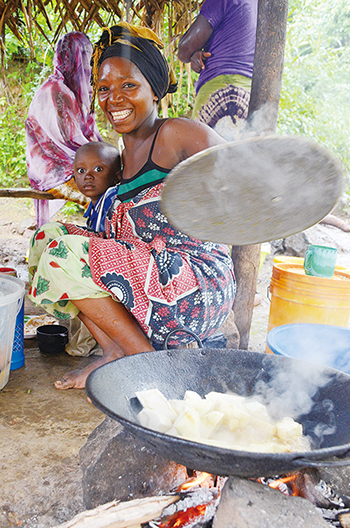
A woman sells deep-fried cassava at a restaurant in Tanzania. (Photo: Takeshi Kuno / JICA)
Japan has played a proactive role in the efforts of the international community to achieve the MDGs. In this section, the key points of Japan’s diverse efforts are highlighted for each goal.
Goal 1 is to eradicate extreme poverty and hunger. “Eradicate extreme poverty” is a challenge that ties in with Japan’s development cooperation policy as a whole, and is explained in further detail in Chapter 2, Section 2. With regard to “eradicate hunger,” assistance in the field of food and agriculture became one of the focal items of the international community’s efforts. In this field, at the G8 L’Aquila Summit held in Italy in 2009, Japan announced assistance of at least $3 billion in 2010-2012 for food security, including agriculture and infrastructure development. As of the end of 2012, assistance of approximately $4.2 billion (commitment base) has been extended. In addition, at the Fourth Tokyo International Conference on African Development (TICAD IV) in 2008 that brought together the leaders of African countries to Yokohama, Japan pledged to provide cooperation to increase agricultural productivity for doubling rice production in African countries over the next ten years. Japan reaffirmed that it would continue to provide this cooperation at the Fifth Tokyo International Conference on African Development (TICAD V) in Yokohama in 2013, and is making steady progress to achieve its goal.
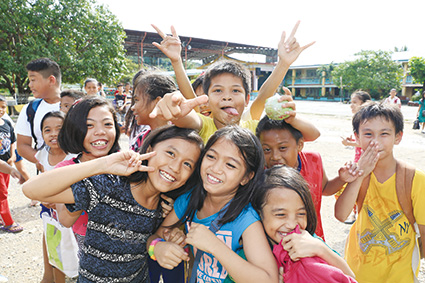
Children attending a public school in the outskirts of Cotabato in the Philippines. (Photo: Masataka Otsuka / JICA)
Goal 2 is to achieve universal primary education. This is another field in which Japan’s contributions and initiatives are wide-ranging. Japan has proactively led the efforts of the international community. Notably, at the UN Summit on the MDGs in September 2010, Japan announced education cooperation amounting to $3.5 billion over five years from 2011. Furthermore, Japan proposed School for All,(Note 2) a basic educational aid model that is designed to improve the learning environment comprehensively, working together with schools, communities, and educational administration. Additionally, at the 2013 TICAD V, participants set goals to increase the enrolment and completion rate and improve the quality of education. On this occasion, Japan newly pledged to provide a quality educational environment for 20 million children and is steadily on course to realizing this.
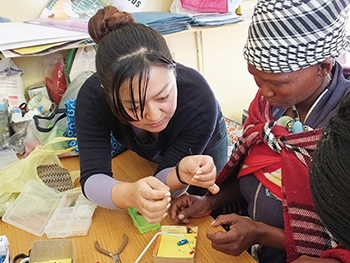
A Japan Overseas Cooperation Volunteer, Ms. Satoko Maruyama teaches local women how to make folk art accessories as part of a program for improving the income of women groups in villages in the Boteti District in Botswana. (Photo: Etsuko Nagayama)
Goal 3 is “gender,” namely, to promote gender equality and empower women. Japan has undertaken steady steps for “gender mainstreaming,” i.e., clarifying and accounting for the development challenges, needs, and implications for men and women in all areas and at all levels of development cooperation to achieve these objectives. In 2005, Japan unveiled the comprehensive policy document, the Initiative on Gender and Development (GAD),(Note 3) at the 49th Session of the UN Commission on the Status of Women held in Beijing.
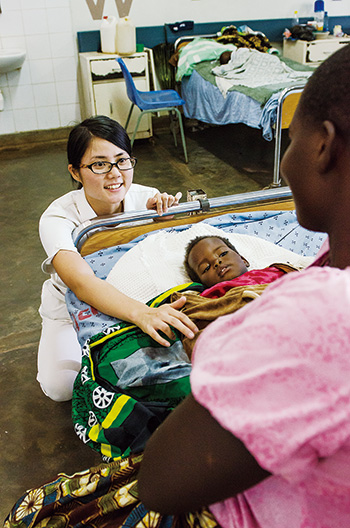
A Japan Overseas Cooperation Volunteer, Ms. Miho Iwasaki asks questions about the state of a two-year old patient suffering from malaria to her mother at a hospital in the Thyolo District, Malawi. (Photo: Kenshiro Imamura / JICA)
The goals related to health, including Goal 4 to reduce child mortality, Goal 5 to improve maternal health, and Goal 6 to combat HIV/AIDS, malaria and other diseases, are challenges for which Japan has led efforts by the international community. In 2002, the Global Fund to Fight AIDS, Tuberculosis and Malaria (Global Fund) was established, which was spun out of the Okinawa Infectious Diseases Initiative that Japan announced at the G8 Kyushu-Okinawa Summit in 2000. Japan has also proactively led efforts by the international community through the G8 Summit fora. At the G8 Hokkaido Toyako Summit in 2008, Japan, as the country holding the G8 Presidency, compiled the Toyako Framework for Action on Global Health, which incorporates the principles for action related to health. At the G8 Muskoka Summit in 2010 held under the Canadian Presidency, Japan announced additional assistance of up to ¥50 billion over five years from 2011 for maternal and child health. In addition, Japan presented Japan’s Global Health Policy 2011-2015(Note 4) at the 2010 UN Summit on the MDGs. Japan announced that under this policy it would provide $5 billion of assistance over five years from 2011, and implement EMBRACE,(Note 5) a maternal and child health aid model aimed at saving the lives of 430,000 expectant and nursing mothers and 11.3 million children including infants. Japan has also steadily made regional-level efforts, including the provision of ¥50 billion of assistance and training of 120,000 African health and medical service providers unveiled at the 2013 TICAD V.
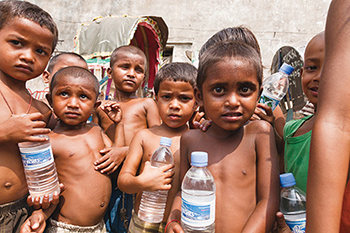
Children in the slums of Dhaka, Bangladesh, receive water through assistance for introduction of water-purifying equipment from Japan. (Photo: Kaku Suzuki / JICA)
Goal 7, to ensure environmental sustainability, is another key development challenge that has significant implications on the people’s lives in developing countries. Environmental sustainability is an area in which Japan has implemented a variety of initiatives, making use of its large pool of accumulated know-how, experience, and technologies related to tackling environmental pollution. For example, Japan announced the Proactive Diplomatic Strategy for Countering Global Warming: Actions for Cool Earth (ACE) in November 2013 through which Japan led the development and spread of innovative technologies and strengthened international partnerships for addressing climate change. In addition to implementing this strategy, Japan has provided an array of assistance using public and private finances. With regard to initiatives to secure water, which is essential for people’s lives, Japan announced the Water and Sanitation Broad Partnership Initiative (WASABI) at the Fourth World Water Forum in 2006 to serve as Japan’s basic guideline for international collaboration. At TICAD V in 2013, Japan committed to improving access to safe water and the sanitary condition for 10 million people. Furthermore, Japan is working to steadily implement concrete measures, including the building of urban waterworks and sewage systems and rural water supply systems.
The last MDG, Goal 8, is to “promote global partnership for development.” For this goal, efforts were made to ensure progress in developing trading and financial systems and dealing with debt problems, among other issues, in order to allow developing countries with various needs and vulnerabilities to achieve economic growth amid globalization, such as least developed countries, landlocked countries, and small island countries. For example, at TICAD V in 2013, Japan announced an assistance package for African growth comprised of public and private measures amounting up to ¥3.2 trillion, including approximately ¥1.4 trillion in ODA for Africa, for the 2013-2017 five-year period.
Aside from these goal-specific initiatives, Japan has led the international community’s discussions and efforts by organizing international meetings related to the achievement of the MDGs.
For example, in June 2011, five years before the deadline for achieving the MDGs, Japan hosted the ministerial-level MDGs Follow-up Meeting in Tokyo. Over 300 people attended the meeting, including delegates and representatives of more than 110 countries (24 minister-level heads of delegations), 20 regions and international organizations, Japanese and international NGOs, and the private sector. The meeting deepened discussions on the concrete challenges facing the international community in the lead-up to 2015 based on the outcome document from the previous year’s UN Summit on the MDGs.
On the occasion of the 66th Session of the UN General Assembly in September 2011, Japan organized an informal ministerial-level meeting on the MDGs. Some 400 members of governments, international organizations, private groups, and NGOs attended. The meeting maintained and enhanced the momentum for the achievement of the MDGs. The discussions offered many suggestions regarding a clear way forward for accelerating future efforts and the content of the 2015 development goals (post-MDGs). Discussions at this meeting contributed to strengthening collaboration among diverse development partners, as well as giving impetus to the subsequent global discussions at a variety of fora.
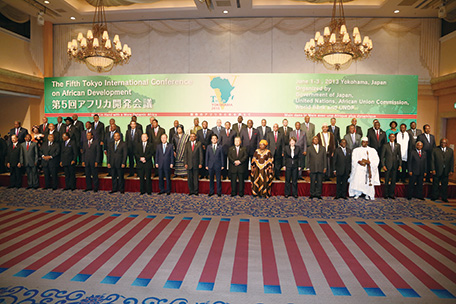
The Fifth Tokyo International Conference on African Development (TICAD V) held in Yokohama in June 2013.
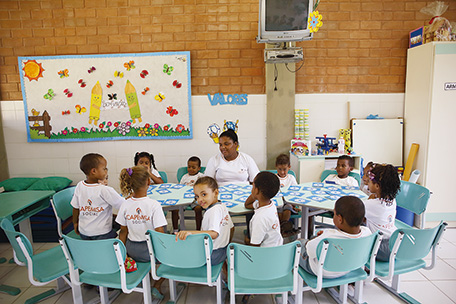
Children in Rio de Janeiro, Brazil, play with “Japan Brazil Friendship Cards” created by the Saitama Prefectural Board of Education. (Photo: Atsushi Shibuya / JICA)
- Note 2: School for All aims to provide a quality educational environment for all children and youths by improving the learning environment comprehensively, working together with schools, communities, and educational administration. To this end, this educational aid model focuses on the following five interrelated components: (i) quality education (teacher training, lesson studies, distribution of textbooks, etc.); (ii) safe learning environment (building of school facilities, school health, and safe water supply); (iii) school-based management (school management with the participation of parents and community members); (iv) schools open to the local community (schools that meet the educational needs of the community, including adult literacy education); and (v) inclusive education (addressing the needs of children in difficult circumstances due to poverty, conflicts, disability, etc.).
- Note 3: The Initiative on GAD is a sectoral development policy that Japan established and unveiled in 2005, a decade after the Fourth World Conference on Women, in order to further strengthen supports for gender mainstreaming in response to the changes in the circumstances surrounding women in developing countries. The Initiative not only focuses on women, but also gives attention to the role of men in eliminating gender inequality. It aims to mainstream a gender perspective in all stages of policy formulation, planning, implementation, and evaluation in all fields of ODA.
- Note 4: Japan pledged to provide $5 billion over five years for health. The policy focuses especially on assistance in the areas of maternal and child health, the three major infectious diseases, and global public health emergencies, with a view to contributing to the achievement of the international development goals, the MDGs.
- Note 5: EMBRACE stands for Ensure Mothers and Babies Regular Access to Care. This aid model was developed based on Japan’s experience during its recovery from World War II. It focuses on ensuring a continuum of care from pre- and post-pregnancy in order to protect the lives of mothers and children.
